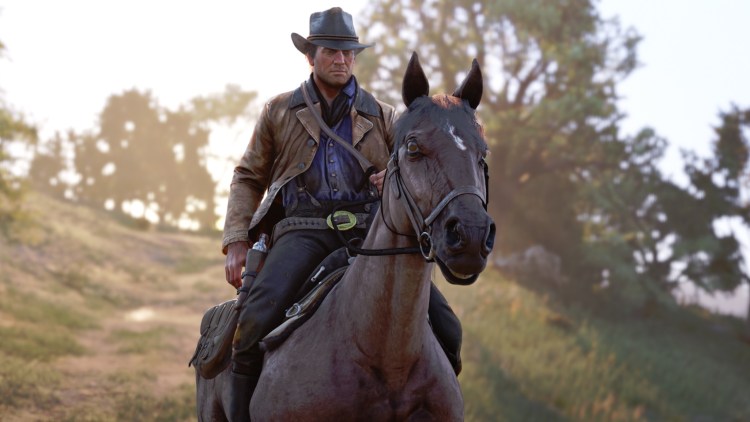Red Dead Redemption 2 main character Arthur Morgan dreams about animals, like a deer moving in slow motion in the wilderness. With the melancholy music, the scene with the deer helps implant the theme of sadness about the vanishing of the outlaw life in the epic Western video game from Rockstar Games.
That Rockstar’s storytellers linger with such moments (as you see in the video here) in the course of a very long game sets this apart from any other I’ve played. It is full of stories and subplots that by themselves would be the basis for an entire game if it another studio had made it.
Arthur is a character who is depicted in depth in this game, and he is one of the rare outlaws who lives by a code. However his story turns out, the larger tragedy is about the disappearance of a way of life and a disillusionment with what America became in the industrial age.
That deer in the dream is a symbol or premonition of some kind of death. But what happens if someone else playing the game sees a wolf instead? That is one of the many things that will make you wonder here.
June 5th: The AI Audit in NYC
Join us next week in NYC to engage with top executive leaders, delving into strategies for auditing AI models to ensure fairness, optimal performance, and ethical compliance across diverse organizations. Secure your attendance for this exclusive invite-only event.
But even as the story takes you on this long ode to the outlaw, it doesn’t glorify the outlaw life. Rather, from the beginning as the gang is in full retreat after a botched robbery, it shows in full color what can go wrong as you cling to romantic lies about the lawless frontier.
This is my full review of Red Dead Redemption 2. I wrote earlier about my impressions when I was about halfway through the game. But now I can see it in full relief. I think I can explain in this lengthy piece why it’s on its way to selling 20 million copies or more.
I think it fits alongside Rockstar’s masterpieces such as 2010’s Red Dead Redemption and 2013’s Grand Theft Auto V. And it takes the story and depth one step farther, as far as this generation’s game consoles can take it.
The world feels alive. It has 10 times the custom animations of GTA V. It has 300,000 individual animations, 1,000 things to do and discover, 500,000 lines of dialogue (or twice the number in GTA V), and more than 1,000 actor performances in the game. (Yes, it is no wonder Rockstar is facing allegations of involuntary crunch, or forced overtime).
I was amazed at the breadth of the experience. I’ve completed 105 missions (I remember GTA V had 69 missions total), and I am 100 percent done with the story. I’ve also reviewed the video I captured of the game to better understand how it all comes together. It takes more than 50 hours to get through that directed part of the game, but there are many more hours you can spend in the open world if you want to explore all of its edges, side missions, and emergent gameplay.

Above: Arthur Morgan strikes out on his own in a lot of missions.
The game left me with a lot to think about. In some ways, the storytellers’ hands were tied. It takes place in 1899, as a prequel to 2010’s Red Dead Redemption, which took place in 1911. If you played the original game, you know who survived from Dutch Van der Linde’s notorious gang, including Red Dead Redemption’s main character, John Marston, who plays a secondary role as one of many gang members in Red Dead Redemption 2.
While the original focuses on Marston, this game focuses on Arthur Morgan and his interactions with all of the characters in the gang. At the center is the charismatic outlaw leader, Dutch Van der Linde,
who, in contrast to his rival Colm O’Driscoll, tries to justify his violence and greed with higher ideals about resistance, freedom, and the extended family of the cult-like gang.
Dutch is like a snake-oil salesman, always getting his gang to believe that one more heist will yield enough money so they can move to some far-off paradise where they won’t be pursued by the law anymore. Arthur is his loyal enforcer who starts to question just what loyalty means as his leader becomes more and more erratic.
From the start, Rockstar paints the gang without glamour. It tests loyalties after a bank robbery goes bad in the town of Blackwater. They have fled into the mountains under cover of a blizzard, and they are searching for their scattered gang members. They are desperate for food and money, and Arthur must provide.
Marston is among the missing. Finding him is one of your first tasks playing as Arthur. The beginning is kind of plodding, but you learn important things like how to ride a horse, track an animal or human in the wild, and hunt. The group sets up camp and you try to help improve the common good by hunting and providing and protecting. And the gang must be ever vigilant about evading federal agents, bounty hunters, and private armies like the Pinkertons.
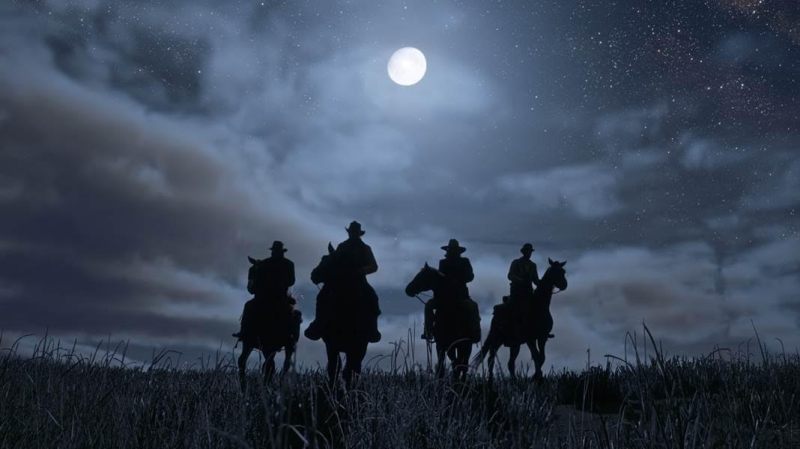
Above: Dancing by the pale moonlight.
It also has better artificial intelligence that appears to sense what you are thinking, particularly in the open world part of the game, rather than the directed story missions.
What this means is that if you follow a nonplayer character into an alley, they will look back at you and start to worry that you mean ill intent. The character will question you or stop walking to confront you. If you have a bounty on your head, the passersby may recognize you and report your presence. If you pass by someone with your gun drawn, they may react in a hostile way. You can defuse confrontations with strangers, or you can antagonize them into attacking you.
If you are known for shooting up a town and then paying off the bounty, the survivors will treat you with disdain. Every now and then, when you are shooting someone, or when you are riding in the wild, or when an important part of the story unfolds, the camera goes into a cinematic mode. When you walk by two women having a conversation, they will begin to include you in the chatter.
All of this helps you feel like you are immersed in a living world.
What you’ll like
An epic story

Above: Red Dead Redemption 2 is an epic adventure.
I’ve already mentioned the living-world cliché. And I don’t always like to throw around the word “epic,” as that’s what marketing departments do in just about every description of any video game. But Rockstar has set itself apart with the quality of its stories. You can find pathos in the loss of the freedom and frontier lifestyle that forms the backdrop to the tale. While they’re not nice people, you spend so much time with them that you want to see them fulfill their dreams of escape.
Just when I thought I was getting a little bored, a new kind of mission appeared. Every now and then, a big twist takes the story in a new direction, and it reminds me that the Rockstar team has some awesome storytellers. I loved getting to know the characters in the gang and viewing life from what otherwise would be viewed as a villain’s point of view. You can get to know the members of the gang during missions, where you can tell if they’re cowardly or brave, or you can spend time talking to them in a more relaxed setting in the outlaw camp.
Arthur was adopted into the gang at a young age, and he is one of the few who has been with the group forever, compared to some who have only been on board for a few months. Arthur buys into Dutch’s dream of living free from the law and societal interference. Dutch treats Arthur like a son, but the gang has a lot of baggage, and Arthur has to decide how much he is willing to follow Dutch. Arthur also has to make choices that tell you whether he’s an honorable outlaw or a dirty scoundrel.
A gang of characters
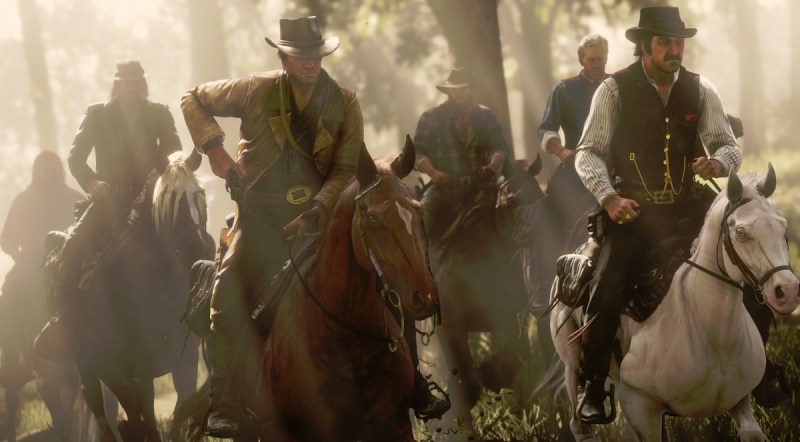
Above: Red Dead Redemption 2 stars Arthur Morgan (left) and gang leader Dutch Van Der Linde.
While Arthur and John are like Dutch’s adopted sons, they don’t get along. Arthur takes a sour view of many things, and he loves to insult his fellow gang members, but he gets along well with the kindhearted ones. He is loyal to Dutch, but he also begins to see through Dutch’s lies. While Arthur has lost his chance for romance, he sees hope in Marston’s family, with his wife Abigail and son Jack.
The gang’s wide cast includes women who can trick men out of their money, a bookish loan shark named Leopold Strauss, a carnival-like con man named Josiah Trelawny, and an aging, wise, and cautious gangster named Hosea Matthews.
Sadie Adler blooms late in the story, but she becomes one of Rockstar’s more memorable female characters. There are shifty characters like Micah Bell, Bill Williamson, and Javier Escuella, and trustworthy ones like Charles Smith, Lenny Summers, and Susan Grimshaw.
On the side of the law, there are relentless pursuers like the industrialist Leviticus Cornwall, who seeks vengeance because Dutch has robbed from him so much, and the Pinkerton agent Andrew Milton. While Dutch evades the law, he must also be wary of rival gang leader Colm O’Driscoll.
As you get to know these characters, they reveal more about the kind of man who Arthur has become, and how he’s different from the likes of Marston and Dutch. And by the end of the story, you’ll see how different characters come to the foreground and why they are there.
Diversity of missions and places
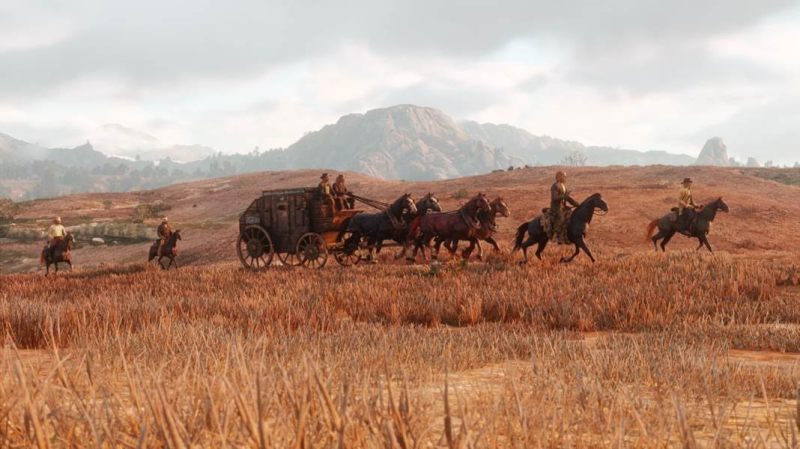
Above: Think there’s some big bucks in that stagecoach?
The story crosses so many regions, like snowy mountains and swamps. You never get lost, as the main story missions show up as yellow dots on the map.
I loved going on missions like a train robbery, a bank heist, or a chase through the woods. You also have random adventures you can pursue. These don’t advance the story, but you can get more resources from them (by looting the enemies you kill) and come face-to-face with interesting moral choices, like whether you should help an escaped convict get out of his chains.
The gang gets chased around multiple states in the fictional American West, and each time it is forced to move, a new chapter in a new place begins. You can explore the snowbound mountain trails of the East Grizzlies, the grassy plains of the heartlands, treacherous alligator-filled swamps, the rapidly modernizing city of St. Denis in the Southeast, as well as the classic Southwest frontier. You’ll also go to a number of places you wouldn’t expect to see in a Western.
With so many missions, you remember the ones that stand out. I recall the ones that involve a hot air balloon, a gator, a 1,000-pound bear, a sniper rife and an old feud, going fishing, jumping off a cliff, a fast-action canoe chase, shooting a Gatling gun on top of a train as an army bears down on you, and building a house.
Amazing graphics and environments
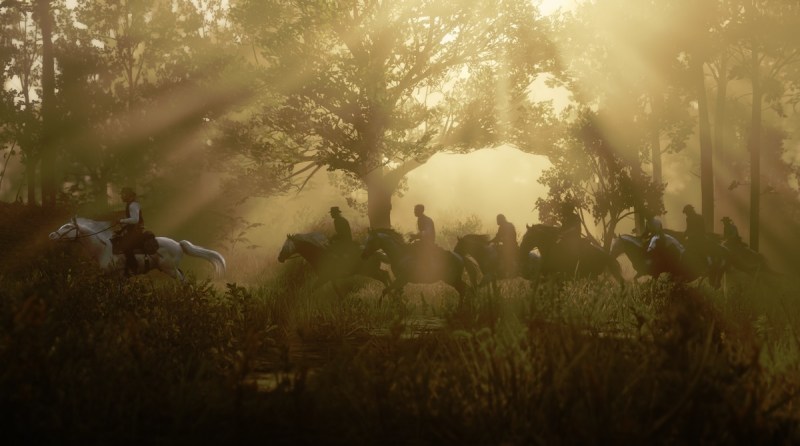
Above: It’s more than the woods and plains.
The tale begins in the snow-covered mountains amid a blizzard. Even on the aging PlayStation 4, the animations of snow particles blowing sideways in the wind look amazingly realistic. The animation of the human faces look superb. The motion captured movements also look real. When you move through the snow, you leave footprints and trails behind you.
The music is stirring, and the developers included 192 separate pieces of original interactive score. The combined effect will make your jaw drop open. The soundtrack and the voice acting make a significant contribution to immersion.
Since the world is huge, you’ll see a wide variety of environments, such as the mesas of the Old West or the industrial factories of modern cities. The facial animations and close-ups of the characters are also believable, getting over the challenge of the “uncanny valley,” or the notion that animated faces look weirder the more realistic they become. I came to think of the characters as people, not animated pieces of code.
Just standing in place and watching the wind blow through the grass, you can see how much work Rockstar put into things like shadows, lighting, ambient sound, music, weather effects, and facial and body animation. The world is visually arresting and it is filled with things to do, and it has a lot of ambient sound and ambient life. I was running down a path, and I laughed when a pig charged up behind me and knocked me over.
The user interface and controls are simple

Above: This is basically like where GamesBeat’s Jeff Grubb lives.
The screen isn’t cluttered with the usual video game heads-up display.
When you need to pull up your inventory, you hit the left bumper and the weapon wheel appears. If you further squeeze the right trigger, you can then see a secondary wheel of items and then quickly select an item you want to use. When you don’t need to see the inventory, it disappears from view.
This kind of weapon wheel and inventory system makes switching weapons during a gunfight simple and fast. The minimap could be bigger, as it feels a lot like a GPS that tells you at the last minute to make a sharp left turn.
When you are in combat, you can target enemies with auto-aiming by squeezing the L2 trigger. But you have to move your right stick to target enemies more precisely. I learned to control the game quickly and fluidly, so that I never had to slow down much to accomplish certain tasks.
That feeds the illusion that you are in a cinematic experience, more like a movie than a video game. When a cutscene comes, black borders appear and the top and bottom of the screen. I had an easy time learning how to ride a horse, as it’s a lot like playing GTA V, except with horses.(And yes, like with cars in GTA V, it’s quite easy to crash your horse). It feels like a lot of thought went into making the user interface less intrusive.
Combat is deeply satisfying
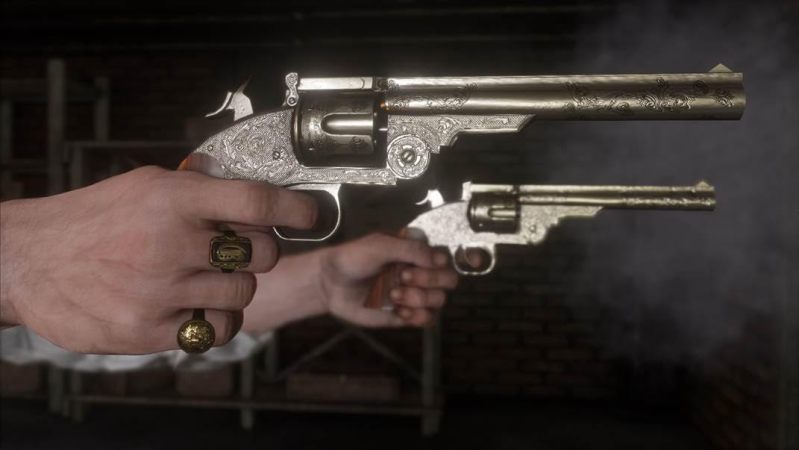
Above: Guns up!
This is a game, not a movie, and you can tell that through the quality of the combat system. As you would expect, the Wild West of Red Dead Redemption 2 spawns a lot of combat opportunities. It is spaced across multiple missions, but every once in a while you get into a gigantic shootout.
The Dead Eye system is back, and it allows you to shift a scene into slow motion for a limited period of time. During that time, you can target multiple enemies at once and shoot them all at once when the slow-motion returns to fast. When you are being chased on horseback, it’s easy to shift the view so that you can turn around and target your pursuers with pistol fire. If you leave yourself exposed in front of the AI enemy, you’ll die quickly.
It’s not perfect combat, as you spend far too much time trying to auto-aim at enemies and then getting no results. Quite often you have to shoot foes four or five times to bring them down. But as you get used to the system, you’ll find yourself trying to get headshots just for the rewards. It has up 50 weapons, and you’ll learn how to use a lot of them. And sometimes, you’ll have more than 50 enemies to shoot in a single battle.
Superb acting

Above: Red Dead Redemption 2.
The voice acting for Dutch Van der Linde (Benjamin Byron Davis) and Arthur Morgan (Roger Clark) is first-rate. I’ve come to expect this from Rockstar’s games, but the quality of the facial animation and the voice acting that feeling of immersion. It’s part of making you care about the characters. The writing is memorable, and the cut scenes are expertly woven into gameplay.
Strangers can be friendly or deadly
I stopped by to help a woman whose horse had died and fallen on her leg. It was out of the goodness of my heart. Then she needed a ride to St. Denis, the city halfway across the map. I took her home, and she rewarded me with a silver ring. But my reputation didn’t change, as far as I could see.
Then I stopped to help a woman who was similarly stranded. Something didn’t look right, so I drew my rifle. She asked me to help. I did. Then she pulled a gun on me and two others came running at me out of the woods. I shot them all.
You never know how one of those encounters will turn out, so you must assess the risk/reward of helping total strangers. It makes you cynical, and it keeps you on your toes at all times.
What you won’t like
Fast travel isn’t fast
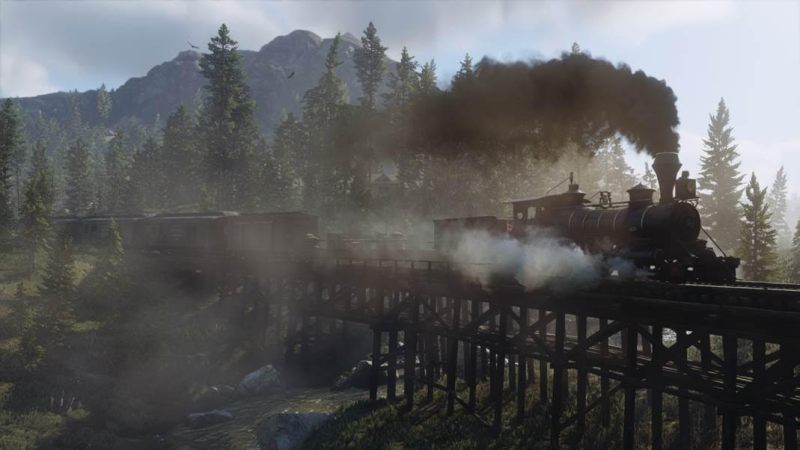
Above: Get on the train!
It wouldn’t have killed Rockstar to put better fast travel into the game. Its system isn’t fast at all. And with a map as huge as Red Dead’s, it’s a form of insanity not to make a way for a player to get from one end of the map to another to start the next mission.
Train stations are a place where you can fast travel. But the tickets cost money. The stations aren’t always near where you want to go. And here’s the killer: If you take a train somewhere, you leave your horse behind. So when you arrive at the train station, you either steal another horse, or you walk. I never once took a train for this reason. And it cost me hours and hours of extended riding through the country. In a 50-hour game, that is maddening.
So many other things slow you down. You track animals in slow motion. If you want to shave your beard off, you have to do it. If you want to move from one side of the camp to another, you can’t run. With so much emergent gameplay, I can see why Rockstar didn’t want to use fast travel. But they should have left the choice of using it up to the players.
Occasional bugs reveal the game’s limits
Just when you think that you’re not in a video game, and this all seems so real, little bugs remind you that it’s not perfect. I parked my horse, and its head became stuck in a tree. My wagons became inextricably stuck in rock formations. One of my horses died because it was stuck in a rock. I tried to dock a boat alongside a ship, and it didn’t work. The horses have a habit of shaking back and forth, as if they were stuttering.
It’s a big game, and a lot of the animations don’t look polished. Pathfinding is difficult, and so you rarely see all of the gang members together on missions. Usually, it’s just a couple of characters involved in most of the journeys. Every now and then, the targeting system seems really slow, like early in the game when you have to shoot a bunch of wolves. These flaws knock you out of the fantasy. Fortunately, if you think of the bugs per area of the game, or bugs per hour of gameplay, they are surprisingly rare.
Some missions just waste your time
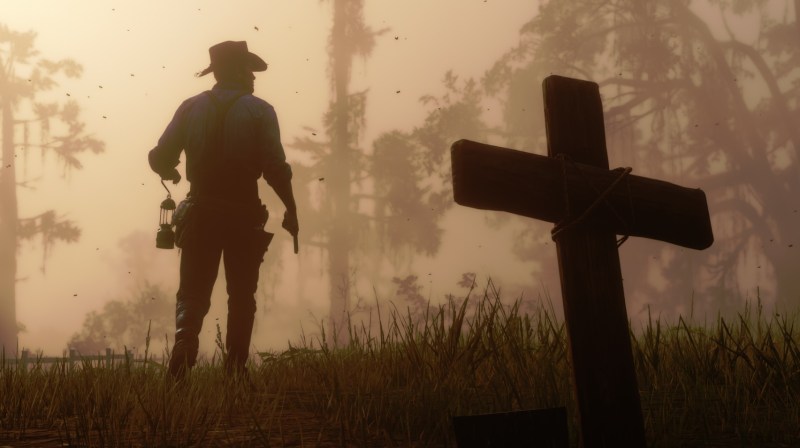
Above: Nope. Not dead yet.
One of the gang members Lenny comes rushing into camp, saying that Micah has been arrested and may be hanged. So Dutch tells Arthur to go out and rescue Micah. But first, Dutch says Lenny is so shaken up that Arthur should take him to the saloon to get drunk first.
So they go get drunk and you waste a bunch of time, where Arthur can see straight and he has to search through the whole saloon to find someone who looks like Lenny. This happens several times, and you finally pass out and wake up.
Meanwhile, Micah is just sitting in the jail in another town, awaiting a hanging or a rescue. I have no idea why this mission made the cut among the 105 mostly purposeful missions. I suppose it tells us something about the outlaw life — getting drunk. But it was painfully drawn out and not funny. This is one of those cases where you wish you could take control of the story, rather than have Rockstar control it for you.
Your horse can be hard to control

Above: Don’t jump off the cliff, horse.
It’s hard to avoid pedestrians sometimes. You hit them with your horse and cause a major incident. Other bystanders will report you for an unarmed assault, and the law will come after you. They may kill you, or you may kill them. But either way, you will end up with a bounty on your head.
And when you are riding fast through the wilderness, you occasionally will be unhorsed as you ram straight into a big rock or tree. This is a major unintended consequence of having realistic physics in the game. You can’t just put the brakes on the horse or your wagon easily, or turn on a dime, the way you can in Rockstar’s Grand Theft Auto games, where vehicle maneuvering is a lot more precise. I would have preferred no consequence at all for bumping into a rock.
I got bounties on my head — or shot a few times — because I accidentally ran my horse into the people who were passing by on the narrow dirt trails of Red Dead Redemption 2. I also shot a horse out from under someone who was fleeing. That saved me from having to shoot the guy, but it mean that I later had a bounty on my head for animal cruelty.
This taught me to be more careful, because the world reacts to my ineptitude, but I wished I could rewind these actions so that they weren’t so consequential. For instance, one of these simple screw-ups led me to losing my horse, which is like losing a character in the game. You can invest a lot in your horse, and if you lose it, you’ll feel sad. So steer it wisely.
Small details don’t mesh
At the end of a bank heist, I scored about $20,000. The share for the whole gang was around $12,000. That was a huge amount for the destitute group. But when I proceeded to play further, the gang still only had a few hundred dollars. That bank heist was tough, but I didn’t get the rewards. That didn’t make sense, as it should have been enough for our whole gang to escape to a better place.
Dutch always says the gang needs more money, but he never says how much, or where the gang’s money disappears to every now and then. If I knew that, I would know how much stuff to steal in any given region. I felt like the failure to do proper accounting just stretched the story out longer, as Dutch could pretend we didn’t have money when we really did.
Animations can be stiff
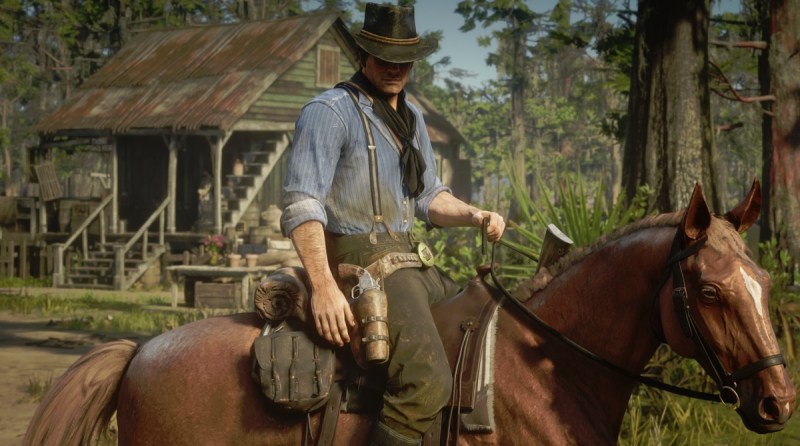
Above: Arthur makes riding a horse look easy in this screenshot.
Nothing ruins the realism of a game as a lousy animation. Throughout the game, you see characters move in awkward ways, like they’re skating on the ground. I had a hard time tethering my horse sometimes. The characters may look perfect, but if they don’t move as humans do, or if they get in each other’s way. There’s often a lag between when you do something, like press a button to dismount, and when it actually happens. That makes you have to press the button again.
Flawed narrative paths
In the Lemoyne region, you come across two feuding families, both of them owners of plantations. There’s a Romeo and Juliet plot here, where one of the sons in one family falls in love with the daughter in the other family. Arthur plays messenger between them, working for pay. The whole story plays out and the feud gets worse.
There’s a chance to unite the star-crossed lovers. But it is just a side mission. Since it wasn’t part of the main narrative, I never learned how that part of the story ended. This seemed like an obtuse outcome, as they should have told us what happened to Romeo and Juliet.
There are also times when confrontations should result in one character being dead, the other standing. But Rockstar appears to want to drag out these confrontations across many more hours.
Choices that aren’t real choices
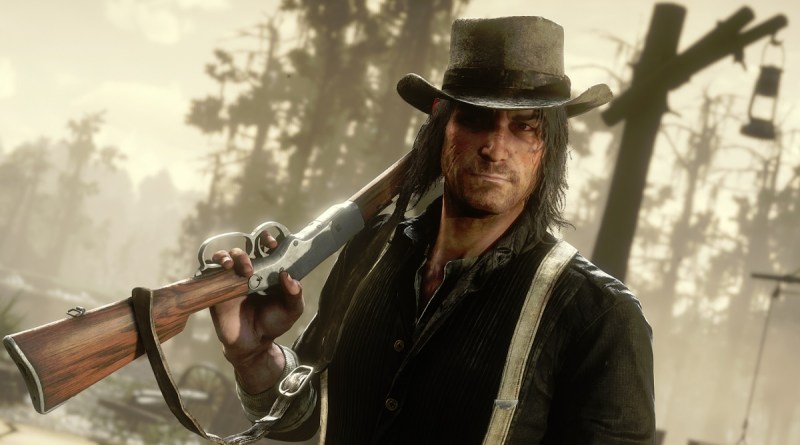
Above: John Marston was the hero of Red Dead Redemption, and he is back in Red Dead Redemption 2.
You have an option to question a captive or beat a person. You can’t extract information nicely, and so your only choice is to be in character, an outlaw, and do what an outlaw would do. Arthur doesn’t seem to have as many choices to be good — or bad — as you might think in this open world. As Dutch says early in the game, “We’re bad men, but we ain’t them.”
On the other hand, if you make a series of mistakes, you may be forced to give up your progress and start over. That’s because you may make the wrong calls and handicap your character. I found at one point that I had hundreds of dollars on my head, and that brought out the bounty hunters. If too many bounty hunters are on your trail, then you won’t be able to get anything done.
So I had to spend a lot of time on schemes to come up with cash so I could pay my bounty. That was a challenge, and it made me wish the game didn’t remember so much about the dumb things I did. The point is that you can dig yourself a hole so deep that you may have to start over to progress further in the story. You almost feel like you are doomed to be an outlaw.
Some mysterious stay mysterious

Above: Arthur Morgan dreams of deer moving in slow motion.
If you’re looking for an answer about why that deer keeps coming up in recurring dreams, you don’t really get an answer. Perhaps you see the deer if you’ve been good in your life. The game doesn’t explicitly explain itself to you. Nor do you get an explanation for why the epilogues go on the way they do. You’ll also wonder why the game ends the way it does.
But this isn’t really something to complain about. With most games, you don’t have something to figure out. If you want things spelled out for you, you won’t get answers. But if you want to interpret things for yourself, you’ll like this aspect of the game.
Conclusion
The above list may seem like a long list of things not to like. And hopefully, some of these illusion-breaking bugs will be stamped out with early patches. The bugs are unsettling, considering it took a huge team about eight years to make this game.
But make no mistake: Red Dead Redemption 2 is a masterpiece. I see these flaws as small distractions, but they don’t kill my enthusiasm for the game. Those bugs seem like nitpicking against scenes like the one in the video above, as Arthur rides to the sound of a beautiful song.
It is a long experience. Parts of it are tedious. It’s a big ask to get players who are accustomed to nothing but pure action to embrace a game like this which has a lot of dead time. But Rockstar sent a lot of messages with the full arc of the game. Like how violence isn’t always the answer. Like how the life and death of a gunslinger isn’t nearly as glamorous as we have all been taught. In some ways, these messages negate the Rockstar games that have come before it, as they have been awash in violence. Yet the messages were delivered skillfully, without heavy-handed storytelling.
I loved so many things about this game, even down to the story in the final credits. It was sad to finish it, but so rewarding.
Rockstar has done a brilliant job blending an open-world game experience with the freedom of discovery and balancing that with the tightly woven narrative. Nearly 3,000 people are listed as contributors to the game. I don’t know if we’ll see the like of this again.
Red Dead Redemption 2 is an amazing work of art.
Score: 96/100
Red Dead Redemption 2 debuted on October 26 for PlayStation 4 and Xbox One. Rockstar provided GamesBeat with a physical copy of the game for the purpose of this review.
